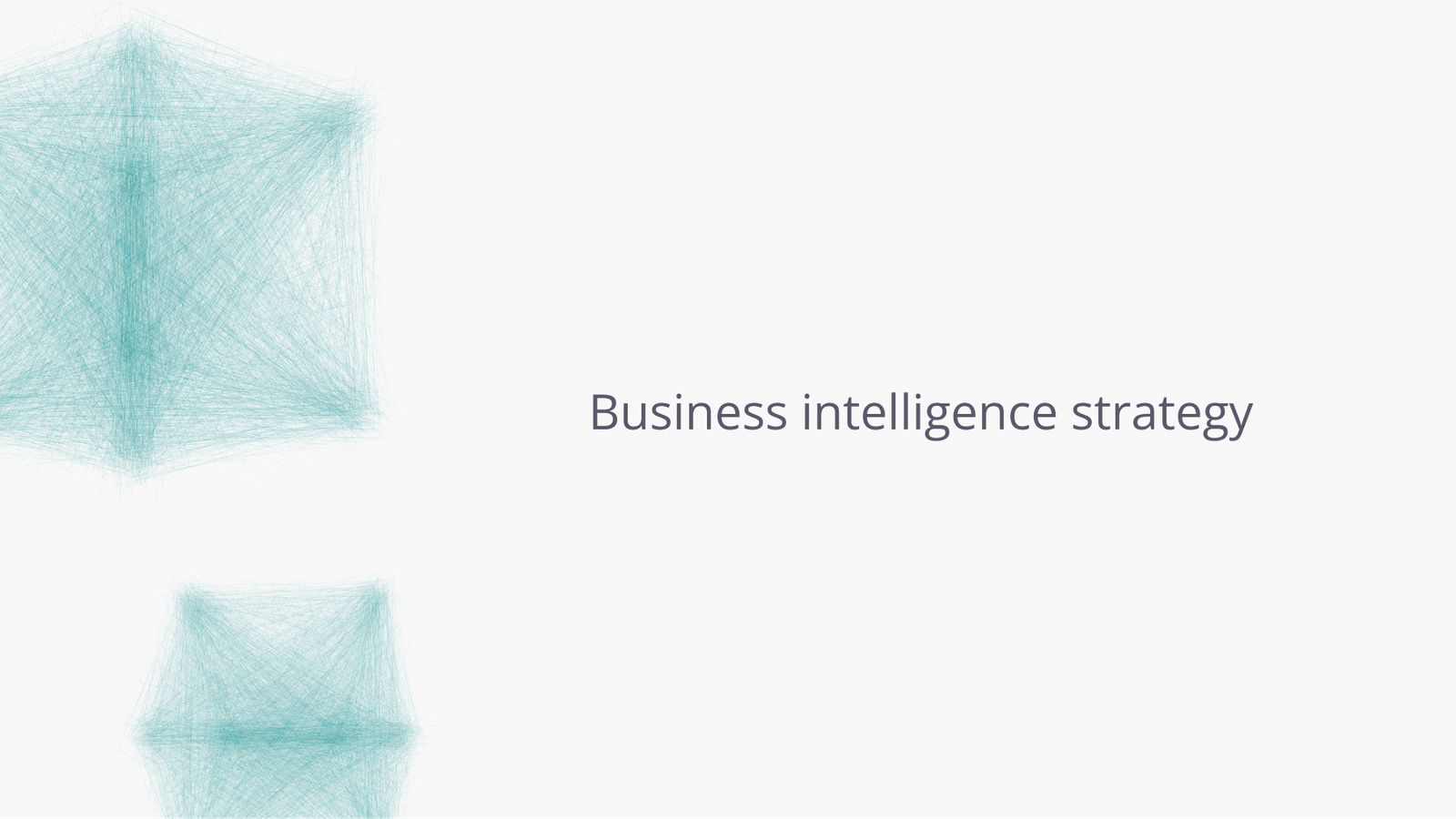Tyler Von Harz, Community Partner
Nov 5, 2025

These days, many organizations invest heavily in dashboards, analytics platforms and a load of extra tools, yet surprisingly few succeed in turning those investments into sustained decision-making power. Without a clearly defined business intelligence strategy, the promise of gleaning insight from data too often falls short.
It’s one thing to deploy top business intelligence tools or experiment with different business intelligence and analytics tools. But it’s quite another to design a purposeful BI strategy that aligns data, analytics, reporting, adoption and governance with business outcomes.
A well-constructed business intelligence roadmap is all about evolving your organization’s ability to act on insight. When organizations approach BI as a one-time project, rather than as a continuous capability, they risk creating flashy visualizations with little decision-making impact.
This article will help you avoid that mess. We will guide you through how to build a business intelligence strategy, define that strategy, shape your reporting motion, and implement a scalable business intelligence framework. We’ll look at just how the right BI implementation strategy and BI adoption plan turn raw data and powerful tools into real-world decisions. And how you can move from dashboards to decisions.
What even is a modern BI strategy?
A modern business intelligence strategy might look like it is built around dashboards or a shopping list of top AI business intelligence tools. Instead, it is a deliberate plan for how an organization will translate data into decisions that consistently improve performance.
The test of a strong BI strategy is simple: does the data being collected actually change what people decide to do tomorrow? If not, the strategy needs work.
A good BI strategy starts with business outcomes, not the data itself. It identifies the decisions that matter most, such as winning customers, improving margins, reducing churn, and then it works backward to ensure the right inputs, models, and reporting exist to support those decisions.
It also assumes things will change. Leaders shift priorities. Teams evolve. Data sources multiply. BI must be a capability that adapts, not a static initiative. This is where a business intelligence roadmap comes in: it gives you an order of operations so capabilities mature over time instead of collapsing under their own weight.
Business intelligence requires trustworthy data, but also clear accountability. Someone must own the definitions behind every metric. Someone must govern how data is modeled. Someone must ensure people actually use the reports they’re given. Without this structure, this business intelligence framework, you will end up producing attractive dashboards that nobody believes, and adoption stalls before value appears.
How different business intelligence strategies fit together
Many BI strategies sound similar but serve different purposes. The main strategy sets the vision: why BI matters, which decisions it supports, and how success will be measured. It is the umbrella under which every other plan sits.
A business intelligence data strategy answers the supply question:
- what data is needed
- how that data is shaped
- how quality and governance are protected as complexity grows
Without it, reporting teams spend more time fixing data than analyzing it.
A business intelligence reporting strategy handles the demand side. It defines how insights get delivered. Which KPIs are standardized, which dashboards become the “official record,” and how report design supports fast interpretation. This is how BI moves from raw numbers to something that gives you operational clarity.
An enterprise BI strategy brings scale into the picture. As more teams rely on analytics, the approach must work across departments, geographies, and levels of data literacy. Shared models, shared tools, shared governance. This is the difference between a BI capability that works for one team and one that lifts the entire organization.
When these pieces align, BI implementation strategy becomes execution rather than experimentation. The rollout has a destination. Adoption is measured and supported rather than hoped for. And instead of a long list of dashboards, companies develop a system that actually improves decisions, which is the primary reason business intelligence exists in the first place.
The BI roadmap - how to turn a business intelligence strategy into execution
Organizations without a clear roadmap struggle to move beyond surface-level reporting and rarely realize the full potential of their investments.
The strongest BI rollouts begin with a single use case that proves measurable value, then expand through iteration and habit. Implementation success depends on a few things: visible executive support, clear ownership of KPIs, and enough flexibility to evolve with changing goals.
Phase 1: Assess your current state
Before you build out your business intelligence roadmap, start by understanding where you are. The goal is to capture the current maturity of your BI capabilities: what data assets you have, how analytics are being used, which dashboards are adopted, where the bottlenecks lie, and how decisions are currently being made (or not). According to a guide by NetSuite, this includes conducting a data inventory, auditing your BI architecture, and understanding business use cases.
This assessment helps you avoid launching a full-scale BI implementation strategy without knowing what gaps already exist.
Phase 2: Define the target state and value cases
After understanding the current state, you next articulate where you want to go. What does an ideal enterprise business intelligence strategy look like in your organization two to three years out? At this stage, you identify high-value use cases, align them to business outcomes (for example: reducing churn by 10% or speeding up financial close by 20%), and decide which parts of the business will be early adopters. Having articulated the target state gives clarity to your business intelligence plan and helps prioritise which capabilities matter most.
Phase 3: Build the toadmap
With current state and target state defined, you create your roadmap. A well-constructed business intelligence roadmap lays out how you move from where you are to where you want to be. According to an article from Airfocus, the purpose of the roadmap is not just listing features, but visualising key milestones, dependencies, business goals, and analytics outcomes.
In practice, your roadmap might include phases like:
- Pilot phase: launch a single high-impact dashboard for one business unit.
- Build phase: integrate additional data sources, develop core semantic models.
- Scale phase: roll out self-service analytics across multiple domains, embed analytics in operational workflows.
- Optimize phase: measure adoption, retire unused reports, refine KPIs and processes.
Each phase should have realistic timelines, responsible parties, and measurable outcomes.
Phase 4: Implement, monitor, and adapt
Execution is where many plans break. Having a roadmap is essential, but you must treat it as a living plan. You implement in waves, monitor usage and business impact, measure adoption, and adapt the roadmap based on feedback and shifts in business strategy.
To get the right idea, you should conduct annual reviews (or even more frequently) of your BI strategy and roadmap to ensure that you and your team remain aligned. Use dashboards to measure the dashboards themselves: How many users log in each week? Which dashboards are being used? What decisions did they enable?
Phase 5: Embed continuous improvement
A strategic BI effort never truly finishes. You should build your roadmap with an implied continuous-improvement phase: refine models, retire outdated reports, develop advanced analytics, extend to new data sources, and increase user sophistication. This is part of moving BI from “project” to a continuous capability. A data strategy roadmap framework recommends taking an MVP (minimum-viable-product) approach initially, then evolving the roadmap as your maturity grow
The tools landscape: making strategy real
Every business intelligence strategy and roadmap relies on technology to make its principles tangible. Tools don’t define the strategy, but they shape how quickly it can scale. The modern AI business analytics tools ecosystem is broad, yet most fall into a few clear categories:
- Quadratic – hybrid spreadsheet for Python + SQL + live data
- Power BI – scalable Microsoft integration
- Tableau – visual exploration and storytelling
- Looker – governed semantic modeling
- Qlik Sense – associative data discovery
- ThoughtSpot – natural-language querying
- Mode / Domo – embedded analytics and collaboration
- Snowflake / Databricks – unified cloud data platforms
These tools give structure to a business intelligence data strategy and deliver the reporting, governance, and automation needed for enterprise-grade analytics. Power BI and Tableau anchor self-service; Looker and Qlik enforce governance; Quadratic makes the analytical layer interactive and explainable; and Snowflake or Databricks keep everything fast and consistent underneath.
When chosen with purpose (mapped directly to business needs, maturity, and culture) the stack becomes an expression of your BI framework itself.
Making the most of your business intelligence strategy
A business intelligence reporting strategy should make decisions easier, not dashboards prettier. The goal is to standardize what every metric means, so people stop arguing over numbers and start acting on them. When marketing, finance, and operations each define “customer churn” differently, reports lose power before they’re even opened.
A modern business intelligence strategy treats reporting as part of the product of decision-making. Scorecards exist to track commitments; dashboards exist to explore the “why.” Both should lead somewhere. An action, a change, a conversation. If a report doesn’t prompt movement, it’s noise.
Good reporting systems also work in real time. Automated alerts replace endless refreshes, surfacing what changed and why. When that loop tightens, that event to alert to response, you stop reporting on the business and start steering it.
Building adoption into the process
Even the most carefully designed enterprise BI strategy fails if no one uses it. Low trust in data, complex interfaces, and poor training stop adoption cold. Successful BI programs treat adoption as part of the plan, not something to worry about later.
Data literacy programs make people comfortable interpreting metrics. Centers of Excellence keep governance consistent and provide a place to ask questions. Analytics champions inside each department keep momentum going when the central team is busy. Over time, the signs of success are simple: users log in without being told to, new dashboards replace old spreadsheets, and meetings start with data instead of opinions.
Adoption means continuous reinforcement until using analytics feels normal.
Adopt a smarter business intelligence strategy
One of the most challenging parts of business intelligence is turning insights into action before the moment passes. That handoff where you go from the dashboard to the decision is where most systems stall.
Modern business intelligence and analytics tools aim to close that gap by keeping context, data, and logic together. Quadratic, for example, combines querying, analysis, and sharing in a single live spreadsheet-like workspace. It lets you and your users explore, explain, and act without switching between dashboards, notebooks, and messages.
If you want faster and more reliable decisions, review how insights move through your current BI framework. Count the steps between asking a question and getting an answer you can trust. The fewer steps there are, the stronger your BI strategy becomes. And tools such as Quadratic are built to make that happen.

